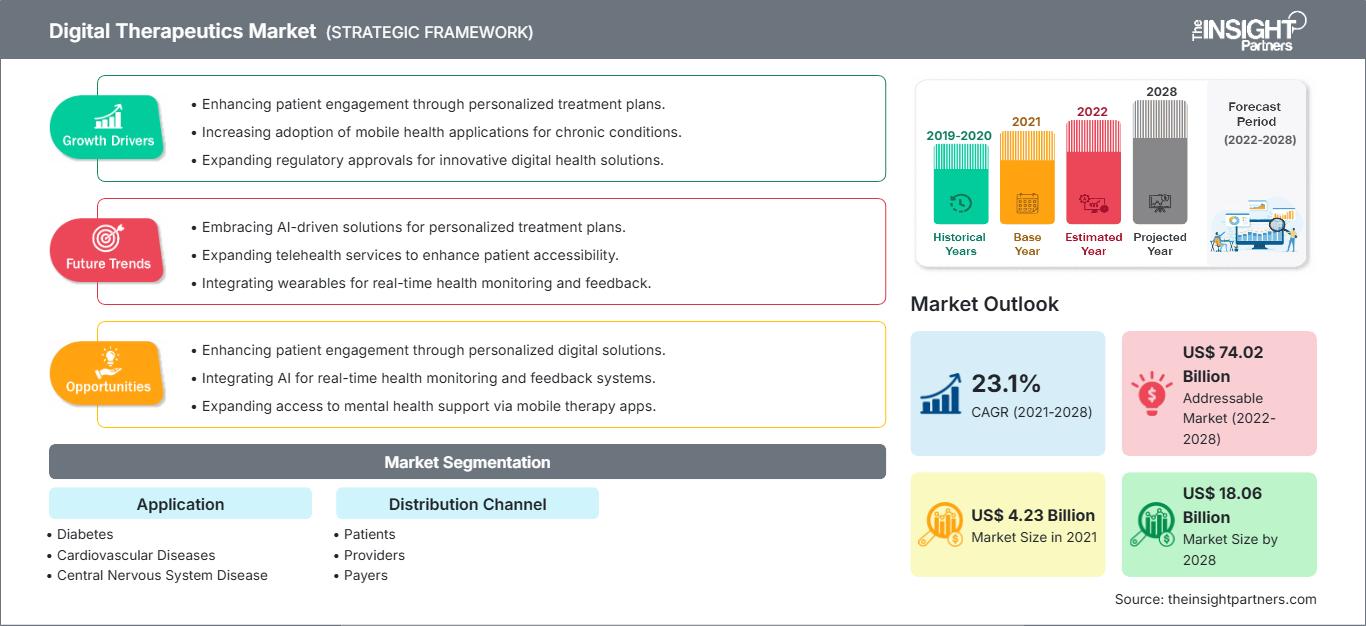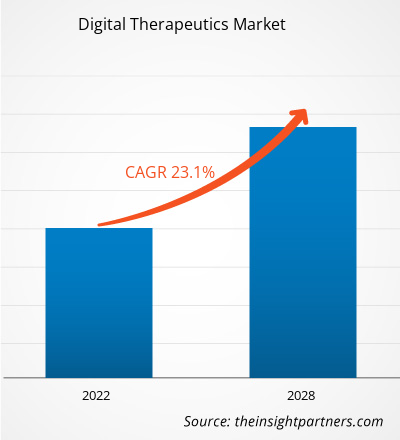[研究报告]2021年数字治疗市场规模为42.2694亿美元,预计到2028年将达到180.6179亿美元;预计2022年至2028年的复合年增长率为23.1%。
分析师观点
市场增长的驱动力可能是由发达国家和新兴国家智能手机普及率的提高、数字医疗技术对医疗服务提供者和患者的成本效益、以及对综合医疗保健系统和以患者为中心的治疗的需求的不断增长所致。据Kepios称,到2021年4月,全球互联网用户将达到42.7亿,占全球人口的60%以上。随着这一数字的增长,人们对智能健康追踪的认识预计将会提高。发达经济体的消费者越来越关注用于治疗疾病的创新医疗产品。根据经济合作与发展组织 (OECD) 的数据,由于多个经合组织国家的经济状况恶化以及医疗支出增加,2020 年医疗保健支出占 GDP 的比重大幅攀升。因此,人们的偏好转向了先进的医疗服务,包括对先进治疗设备的需求不断增长。产品接受度是推动市场扩张的另一个因素。
市场概览
数字疗法为患者提供循证治疗干预,专注于通过程序治疗疾病,并使用高质量软件进行管理。数字疗法在过去几年中取得了进展,利用技术补充或可能取代传统的临床疗法。它们可以单独使用,也可以与设备、药物或其他疗法配合使用,以优化患者护理和健康结果。推动数字疗法市场增长的关键因素是慢性病患病率的上升、对降低医疗成本需求的担忧以及企业之间的伙伴关系和合作。然而,网络威胁和数据安全性的提高阻碍了市场的增长,限制了其在医疗领域的潜在应用。
自定义此报告以满足您的要求
您将免费获得任何报告的定制,包括本报告的部分内容,或国家级分析、Excel 数据包,以及为初创企业和大学提供超值优惠和折扣
数字治疗市场: 战略洞察

- 获取本报告的主要市场趋势。这个免费样本将包括数据分析,从市场趋势到估计和预测。
您将免费获得任何报告的定制,包括本报告的部分内容,或国家级分析、Excel 数据包,以及为初创企业和大学提供超值优惠和折扣
数字治疗市场: 战略洞察

- 获取本报告的主要市场趋势。这个免费样本将包括数据分析,从市场趋势到估计和预测。
市场驱动因素
慢性病患病率上升推动数字治疗市场增长
包括心脏病、中风、糖尿病和肥胖症在内的慢性病占所有国家医疗保健费用的大部分。根据世界卫生组织 (WHO) 的报告,2020 年全球有 4.63 亿成年人患有糖尿病,预计到 2045 年这一数字将上升到 6.29 亿。亚太地区、欧洲以及中东和非洲的糖尿病患病率很高。这种疾病的主要特征是由于身体无法产生或有效利用激素胰岛素而导致血糖水平调节不足,并且没有专门的治疗方法。根据国际糖尿病联盟 (IDF) 发布的《2021 年 IDF 糖尿病地图集》显示,到 2021 年,北美约有 5100 万人患有糖尿病,预计到 2045 年这一数字将达到 6300 万人。此外,东南亚约占全球糖尿病人口的 16.8%。到 2035 年,预计美国约有 1.3 亿成年人将患有某种形式的心血管疾病 (CVD)。
由于久坐和不健康的生活方式,全球发达经济体和发展中经济体的肥胖率都在迅速上升。根据经济合作与发展组织 (OECD) 2017 年发布的数据,OECD 地区约有 19.5% 的成年人口肥胖。韩国和日本的这一比例不到 6%,而匈牙利、新西兰、墨西哥和美国则超过 30%。此外,在过去十年中,澳大利亚、加拿大、智利、南非和英国的肥胖率迅速上升,约有25%或更多的成年人肥胖。预计到2030年,美国、墨西哥和英国的肥胖率将分别达到约47%、约39%和约35%。
为了加强慢性病管理并为患者提供更多治疗选择,数字疗法有助于提供循证治疗方案。它使患者能够更好地控制自己的护理,并为糖尿病等慢性病管理提供潜在的解决方案。因此,慢性病患病率的上升正在推动数字疗法市场的发展。
分段分析
基于应用的洞察
根据应用,数字疗法市场细分为呼吸系统疾病、中枢神经系统疾病、戒烟、肌肉骨骼疾病、心血管疾病、糖尿病和其他应用。 2021 年,糖尿病领域占据了数字治疗市场的最大份额,预计在预测期内,该领域将实现最高的复合年增长率,原因是全球糖尿病发病率不断上升、发展中国家肥胖症患病率高以及肥胖相关疾病带来的巨大风险和经济成本。
糖尿病是一种危及生命的慢性疾病,目前尚无专门的治疗方法。其主要原因是人体无法产生或有效利用胰岛素。这种无能导致人体无法充分调节血糖水平。糖尿病有两种类型:I 型糖尿病(也称为尿崩症)和 II 型糖尿病(也称为糖尿病)。全球糖尿病的发病率和患病率正在稳步上升。II 型糖尿病是最常见的糖尿病类型,并且随着文化和社会变革而有所增加。在高收入国家,多达 91% 的成年糖尿病患者患有 II 型糖尿病。根据国际糖尿病联合会 (IDF) 2021 年地图集,全球约有 5.37 亿人患有糖尿病,预计到 2030 年将达到 6.43 亿。
基于分销渠道的洞察
就分销渠道而言,数字治疗市场分为患者、提供者、付款人和雇主。患者细分市场在 2021 年占据了最大的数字治疗市场份额。然而,预计提供者细分市场在预测期内的复合年增长率最高。
数字治疗市场区域洞察
The Insight Partners 的分析师已详尽阐述了预测期内影响数字治疗市场的区域趋势和因素。本节还讨论了北美、欧洲、亚太地区、中东和非洲以及南美和中美洲的数字治疗市场细分和地域分布。
数字治疗市场报告范围
| 报告属性 | 细节 |
|---|---|
| 市场规模 2021 | US$ 4.23 Billion |
| 市场规模 2028 | US$ 18.06 Billion |
| 全球复合年增长率 (2021 - 2028) | 23.1% |
| 历史数据 | 2019-2020 |
| 预测期 | 2022-2028 |
| 涵盖的领域 |
By 应用
|
| 覆盖地区和国家 | 北美
|
| 市场领导者和主要公司简介 |
|
数字治疗市场参与者密度:了解其对业务动态的影响
数字治疗市场正在快速增长,这得益于终端用户需求的不断增长,而这些需求的驱动因素包括消费者偏好的不断变化、技术进步以及对产品优势的认知度不断提高。随着需求的增长,企业正在扩展其产品线,不断创新以满足消费者需求,并利用新兴趋势,从而进一步推动市场增长。

- 获取 数字治疗市场 主要参与者概述
区域分析
2021年,北美占据了数字治疗市场的最大份额,预计在预测期内仍将保持其市场地位。推动北美市场增长的因素包括降低医疗成本的需求日益增长、医疗法规日益严格、医疗行业竞争日益激烈以及技术创新日新月异。此外,大型医疗企业的存在以及数字治疗技术日益增长的应用正在推动该地区市场的扩张。在北美,美国占据了最大的数字治疗市场份额。数字医疗在美国蓬勃发展,人口老龄化、慢性病患病率上升、监管变化以及向价值导向型医疗的转变等诸多因素,正在推动数字医疗在日常生活中的日益普及。
Propeller Health、Canary Health Inc.、NOOM INC.、2Morrow Inc、Teladoc Health、Welldoc Inc、FITBIT Inc、OMADA Health、Mango Health、Pear Therapeutics Inc 和 Happify Health 是全球数字治疗市场增长中的领先企业。报告还分析了其他几家重要的市场参与者,以全面了解市场及其生态系统。该报告提供了详细的市场洞察,帮助关键参与者制定市场增长战略。下面提到了一些进展:
- 2021 年 11 月,Pear Therapeutics, Inc. 宣布其用于治疗酒精使用障碍 (AUD) 的 reSET-A PDT 候选产品已获得美国食品药品监督管理局 (FDA) 颁发的突破性设备称号。reSET-A 可能会扩大 Pear 的成瘾特许经营权,包括 FDA 授权的治疗物质使用障碍 (SUD) 和阿片类药物使用障碍 (OUD) 的产品。
- 2020 年 9 月,Welldoc 宣布其屡获殊荣的糖尿病平台 BlueStar 获得了美国食品药品监督管理局 (FDA) 的第九个 510(k) 许可。新的批准将胰岛素剂量支持扩展至大多数类型的胰岛素,包括用于 2 型糖尿病的 Bolus 和预混胰岛素滴定。
- 2021 年 5 月,Teladoc Health, Inc. 宣布推出 myStrength Complete,这是一项综合心理健康服务,通过单一、全面的体验为消费者提供个性化、有针对性的护理。
- 历史分析(2 年)、基准年、预测(7 年)及复合年增长率
- PEST和SWOT分析
- 市场规模、价值/数量 - 全球、区域、国家
- 行业和竞争格局
- Excel 数据集
近期报告
相关报告
客户评价
购买理由
- 明智的决策
- 了解市场动态
- 竞争分析
- 客户洞察
- 市场预测
- 风险规避
- 战略规划
- 投资论证
- 识别新兴市场
- 优化营销策略
- 提升运营效率
- 顺应监管趋势




















 获取免费样品 - 数字治疗市场
获取免费样品 - 数字治疗市场